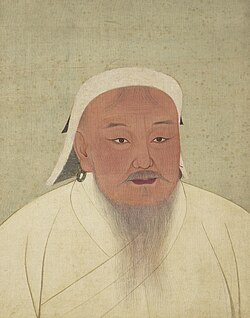Genghis Khan
From Wikipedia, the free encyclopedia
Remove ads
Genghis Khan [note 3] (born Temüjin,[note 1] c. 1162 – 18 August 1227), born B. Temüjin (Audio file "Temujin.ogg" nae foond, wis the foonder, Khan (ruler) an Khagan (emperor) o the Mongol Empire, which became the lairgest contiguous empire in history efter his daith.
He came tae pouer bi unitin mony o the nomadic tribes o northeast Asie. Efter foondin the Mongol Empire an being proclaimed "Genghis Khan", he startit the Mongol invasions that woud ultimately result in the conquest o maist o Eurasie. These includit raids or invasions o the Kara-Khitan Khanate, Caucasus, Khwarezmid Empire, Western Xia an Jin dynasties. These campaigns wur aften accompanied bi wholesale massacres o the civilian populations - especially in Khwarezmia. Bi the end o his life, the Mongol Empire occupied a substantial portion o Central Asie an Cheenae.
Afore Genghis Khan dee'd, he assigned Ögedei Khan as his successor an split his empire intae khanates amang his sons an grandsons.[7] He dee'd in 1227 efter defeatin the Tanguts. He wis buried in an unmarked grave somewhere in Mongolie at an unkent location. His descendants went on tae stretch the Mongol Empire across maist o Eurasia bi conquering an/or creatin vassal states oot o aw o modern-day Cheenae, Korea, the Caucasus, Central Asian kintras, an substantial portions o modern Eastren Europe an the Middle East. Mony o these invasions also resultit in lairge-scale slaughter o the local populations an ar no viewed positively in these parts o the warld today.
Ayont his great military accomplishments, Genghis Khan also advanced the Mongol Empire in ither ways. He decreed the adoption o the Uyghur script as the Mongol Empire's writin system. He also promotit religious tolerance in the Mongol Empire, an creatit a unified empire frae the nomadic tribes o northeast Asie. Present-day Mongolians regard him highly as the foondin faither o Mongolie.[8]
Remove ads
Notes
- English: /təˈmuːdʒɪn/, whiles an aw written as Temuchin or Temujin; Mongolie: Тэмүжин, romanised: Temüjin [tʰemut͡ʃiŋ] (
 listen); Middle Mongol: Temüjin;[1] traditeeonal Cheenese: 鐵木真; simplifeed Cheenese: 铁木真; pinyin: Tiěmùzhēn; Wade–Giles: T'ieh3-mu4-chen1.
listen); Middle Mongol: Temüjin;[1] traditeeonal Cheenese: 鐵木真; simplifeed Cheenese: 铁木真; pinyin: Tiěmùzhēn; Wade–Giles: T'ieh3-mu4-chen1. - Historians o the Mongol empire generally prefer the spellin Chinggis Khaan, that mair closely approximates the name in Mongolie, Чингис хаан [t͡ʃʰiŋɡɪs xaːŋ] (
 listen).[4] The spellin o his name cam oreeginally frae Italian, hyne the pronunciation /ˌdʒɛŋɡɪs ˈkɑːn/, that is similar tae the Italian pronunciation; the seicont G has a follaein H tae produce the soond Template:IPAc-it, as in spaghetti. But acause G afore E in Inglis/Scots is ambiguous (cf. get vs. gel), this leads tae the common pronunciation o /ˌɡɛŋɡɪs ˈkɑːn/, wi baith Gs producin the soond /ɡ/, that has led tae the alternate spellin Jenghis Khan tae try tae prevent this.[5]
listen).[4] The spellin o his name cam oreeginally frae Italian, hyne the pronunciation /ˌdʒɛŋɡɪs ˈkɑːn/, that is similar tae the Italian pronunciation; the seicont G has a follaein H tae produce the soond Template:IPAc-it, as in spaghetti. But acause G afore E in Inglis/Scots is ambiguous (cf. get vs. gel), this leads tae the common pronunciation o /ˌɡɛŋɡɪs ˈkɑːn/, wi baith Gs producin the soond /ɡ/, that has led tae the alternate spellin Jenghis Khan tae try tae prevent this.[5]
The Middle Mongol pronunciation was [ˈt͡ɕʰiŋːɡɪs ˈkaχaːn] or [ˈt͡ʃʰiŋːɡɪs ˈqaχaːn].[6]
Remove ads
References
Wikiwand - on
Seamless Wikipedia browsing. On steroids.
Remove ads

